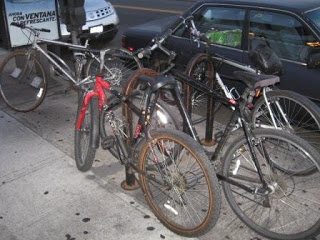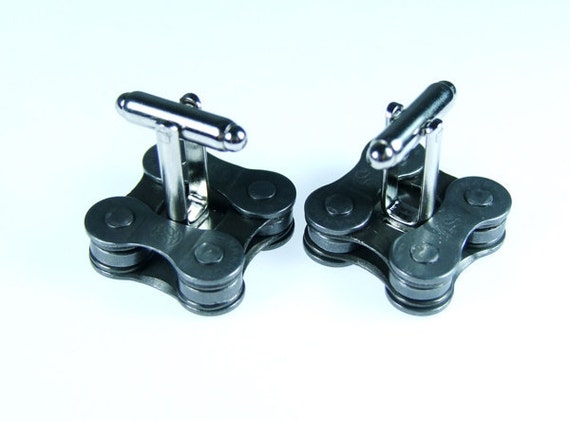Today I walked by my "go-to" takeout (and, sometimes, eat-in) Chinese restaurant. Fatima hasn't changed much, at least in food (fortunately), decor (such as it is) or personnel (again, fortunately) since I first started patronizing it. The changes, it seems, are taking place on the outside.
No, they haven't changed their sign, either. Rather, I am talking about this:
Now, if you live in any large (or, possibly, not-so-large) city, you wouldn't think this scene is remarkable: Three electric bikes (or scooters) parked outside a Chinese restaurant. It's no more unusual than what I saw at the Chinese restaurant across the street, which I go to when Fatima is closed:
These days, electric bikes and scooters are found by most restaurants that offer take-out or delivery service. The most notable exceptions seem to be pizzerias because it's difficult to those wide pizza boxes on an "e-bike". Also, traditional delivery bikes, like the ones made by Worksman, usually have front carrying boxes big enough for pizzas--and wide baskets or Porteur-style racks can be fitted to other kinds of bicycles. It seems that similar boxes, baskets and racks can't be fitted on, or simply not available for two-wheeled vehicles with electric motors.
Compare the first two photos I posted to a couple from the early days of this blog:
Four years ago, most restaurants--like the Bel Aire Diner, where I took the above images--had ragtag fleets of the sorts of bikes one could lock up without fear: everything from old three-speeds, bike-boom era ten- and twelve-speeds and mountain bikes from the '80's and '90's.
Of the bikes parked in front of restaurants, typically, at least one was a "donor" bike, cannibalized for parts that might or not fit on the "receptor" bikes. But somehow those delivery men (Yes, almost all of them are male), who probably knew no more about bike mechanics than I did the day before I opened the pages of Anybody's Bike Book, would find a way to make the brakes from an old Peugeot ten-speed or Raleigh three-speed "work" on a mountain bike--or fit mountain bike wheels and tires on those old Raleighs and Peugeots.
Some might scoff or gasp in horror at such "Frankenbikes". But they at least showed attempts--some successful, or at least admirable--of solving problems with the materials at hand and the limited knowledge most of those delivery men had.
I sometimes see e-bikes similarly cannibalized for other e-bikes. I'll admit I know almost nothing about e-bikes, but I still believe it's safe to assume there isn't nearly as much variation in e-bikes as there is in pedal-powered bikes. If there isn't, I wonder what "Franken e-bikes" (Doesn't have quite the same ring as "Frankenbikes", does it?) will look like.
Probably the most interesting and disturbing thing about this phenomenon of electric two-wheelers is that they constitute, at least in this city, a kind of modern-day Prohibition. No, their riders aren't bringing bootleg gin to clubs (though I wouldn't doubt they're toting other kinds of contraband). Rather, the explosion in the number of such bikes--and the shops that service and sell them--continues even though e-bikes are still illegal here in New York City.
That, ironically, might be a reason why couriers in Manhattan still ride bicycles, most often the fixed-gear variety. Messengers have, shall we say, a bit of a PR problem and the police target them. Even though some messengers take pride in their "outlaw" attitude, they don't want something that subjects them to more scrutiny than they already get.
Also, e-bikes aren't as maneuverable in city traffic, or as easy to park along city streets, as regular bicycles. Thus, whatever advantage in speed e-bikes and scooters might have is negated, especially in heavily congested areas like the Financial District of Manhattan.
It will be interesting, to say the least, to see whether a proposal to allow electric bikes for businesses will ever pass in the City Council. (It's been introduced several times.) I suspect that the Council's vote will not have any influence on whether large numbers of bike messengers abandon their "fixies" for e-bikes.
No, they haven't changed their sign, either. Rather, I am talking about this:
Now, if you live in any large (or, possibly, not-so-large) city, you wouldn't think this scene is remarkable: Three electric bikes (or scooters) parked outside a Chinese restaurant. It's no more unusual than what I saw at the Chinese restaurant across the street, which I go to when Fatima is closed:
These days, electric bikes and scooters are found by most restaurants that offer take-out or delivery service. The most notable exceptions seem to be pizzerias because it's difficult to those wide pizza boxes on an "e-bike". Also, traditional delivery bikes, like the ones made by Worksman, usually have front carrying boxes big enough for pizzas--and wide baskets or Porteur-style racks can be fitted to other kinds of bicycles. It seems that similar boxes, baskets and racks can't be fitted on, or simply not available for two-wheeled vehicles with electric motors.
Compare the first two photos I posted to a couple from the early days of this blog:
Four years ago, most restaurants--like the Bel Aire Diner, where I took the above images--had ragtag fleets of the sorts of bikes one could lock up without fear: everything from old three-speeds, bike-boom era ten- and twelve-speeds and mountain bikes from the '80's and '90's.
Of the bikes parked in front of restaurants, typically, at least one was a "donor" bike, cannibalized for parts that might or not fit on the "receptor" bikes. But somehow those delivery men (Yes, almost all of them are male), who probably knew no more about bike mechanics than I did the day before I opened the pages of Anybody's Bike Book, would find a way to make the brakes from an old Peugeot ten-speed or Raleigh three-speed "work" on a mountain bike--or fit mountain bike wheels and tires on those old Raleighs and Peugeots.
Some might scoff or gasp in horror at such "Frankenbikes". But they at least showed attempts--some successful, or at least admirable--of solving problems with the materials at hand and the limited knowledge most of those delivery men had.
I sometimes see e-bikes similarly cannibalized for other e-bikes. I'll admit I know almost nothing about e-bikes, but I still believe it's safe to assume there isn't nearly as much variation in e-bikes as there is in pedal-powered bikes. If there isn't, I wonder what "Franken e-bikes" (Doesn't have quite the same ring as "Frankenbikes", does it?) will look like.
Probably the most interesting and disturbing thing about this phenomenon of electric two-wheelers is that they constitute, at least in this city, a kind of modern-day Prohibition. No, their riders aren't bringing bootleg gin to clubs (though I wouldn't doubt they're toting other kinds of contraband). Rather, the explosion in the number of such bikes--and the shops that service and sell them--continues even though e-bikes are still illegal here in New York City.
That, ironically, might be a reason why couriers in Manhattan still ride bicycles, most often the fixed-gear variety. Messengers have, shall we say, a bit of a PR problem and the police target them. Even though some messengers take pride in their "outlaw" attitude, they don't want something that subjects them to more scrutiny than they already get.
Also, e-bikes aren't as maneuverable in city traffic, or as easy to park along city streets, as regular bicycles. Thus, whatever advantage in speed e-bikes and scooters might have is negated, especially in heavily congested areas like the Financial District of Manhattan.
It will be interesting, to say the least, to see whether a proposal to allow electric bikes for businesses will ever pass in the City Council. (It's been introduced several times.) I suspect that the Council's vote will not have any influence on whether large numbers of bike messengers abandon their "fixies" for e-bikes.








